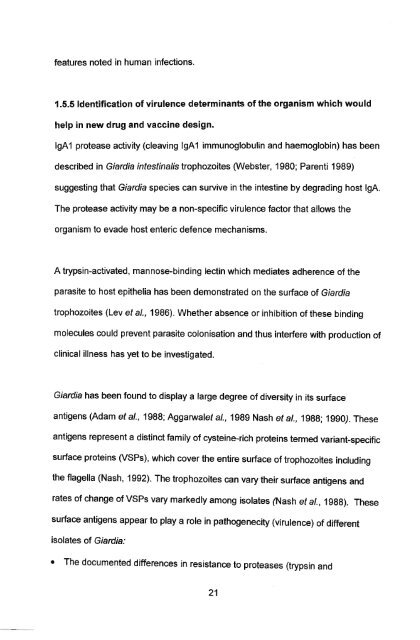in vitro culture and isoenzyme analysis of giardia lamblia
in vitro culture and isoenzyme analysis of giardia lamblia
in vitro culture and isoenzyme analysis of giardia lamblia
You also want an ePaper? Increase the reach of your titles
YUMPU automatically turns print PDFs into web optimized ePapers that Google loves.
features noted <strong>in</strong> human <strong>in</strong>fections.<br />
1.5.5 Identification <strong>of</strong> virulence determ<strong>in</strong>ants <strong>of</strong> the organism which would<br />
help <strong>in</strong> new drug <strong>and</strong> vacc<strong>in</strong>e design.<br />
IgA 1 protease activity (cleav<strong>in</strong>g IgA 1 immunoglobul<strong>in</strong> <strong>and</strong> haemoglob<strong>in</strong>) has been<br />
described <strong>in</strong> Giardia <strong>in</strong>test<strong>in</strong>alis trophozoites (Webster, 1980; Parenti 1989)<br />
suggest<strong>in</strong>g that Giardia species can survive <strong>in</strong> the <strong>in</strong>test<strong>in</strong>e by degrad<strong>in</strong>g host IgA.<br />
The protease activity may be a non-specific virulence factor that allows the<br />
organism to evade host enteric defence mechanisms.<br />
A tryps<strong>in</strong>-activated, mannose-b<strong>in</strong>d<strong>in</strong>g lect<strong>in</strong> which mediates adherence <strong>of</strong> the<br />
parasite to host epithelia has been demonstrated on the surface <strong>of</strong> Giardia<br />
trophozoites (Lev et al., 1986). Whether absence or <strong>in</strong>hibition <strong>of</strong> these b<strong>in</strong>d<strong>in</strong>g<br />
molecules could prevent parasite colonisation <strong>and</strong> thus <strong>in</strong>terfere with production <strong>of</strong><br />
cl<strong>in</strong>ical illness has yet to be <strong>in</strong>vestigated.<br />
Giardia has been found to display a large degree <strong>of</strong> diversity <strong>in</strong> its surface<br />
antigens (Adam et al., 1988; Aggarwalet al., 1989 Nash et al., 1988; 1990). These<br />
antigens represent a dist<strong>in</strong>ct family <strong>of</strong> cyste<strong>in</strong>e-rich prote<strong>in</strong>s termed variant-specific<br />
surface prote<strong>in</strong>s (VSPs), which cover the entire surface <strong>of</strong> trophozoites <strong>in</strong>clud<strong>in</strong>g<br />
the f1agella (Nash, 1992). The trophozoites can vary their surface antigens <strong>and</strong><br />
rates <strong>of</strong> change <strong>of</strong> VSPs vary markedly among isolates (Nash et al., 1988). These<br />
surface antigens appear to play a role <strong>in</strong> pathogenecity (virulence) <strong>of</strong> different<br />
isolates <strong>of</strong> Giardia:<br />
• The documented differences <strong>in</strong> resistance to proteases (tryps<strong>in</strong> <strong>and</strong><br />
21
















